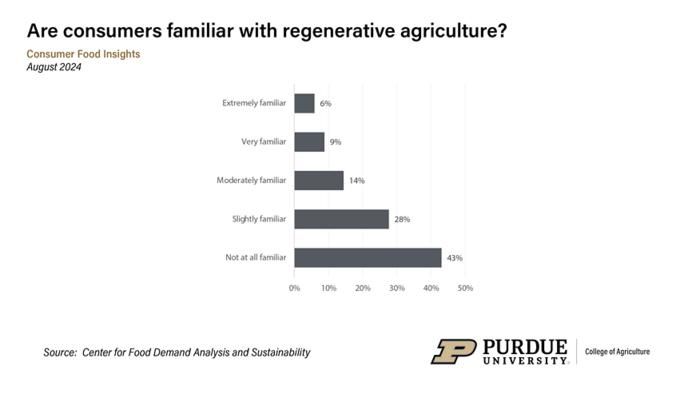Most consumers are unfamiliar or only slightly familiar with regenerative agriculture
Survey also finds increasing importance of food affordability since August 2022
Many members of the public lack familiarity with the farming methods known as regenerative agriculture, according to the August 2024 Consumer Food Insights Report (CFI).

Survey results on consumer familiarity with regenerative agriculture published in the August 2024 issue of the Consumer Food Insights Report.
Source: Center for Food Demand Analysis and Sustainability
The survey-based report out of Purdue University’s Center for Food Demand Analysis and Sustainability(CFDAS) assesses food spending, consumer satisfaction and values, support of agricultural and food policies, and trust in information sources. Purdue experts conducted and evaluated the survey, which included 1,200 consumers across the U.S.
Regenerative agriculture refers to farming methods that result in improved soil health, carbon capture, improved biodiversity and healthy water resources. Around 43% of survey respondents said they were “not at all familiar” with the term “regenerative agriculture,” and another 28% are only “slightly familiar.”
“This reveals an opportunity for producers and industry leaders interested in expanding regenerative agriculture practices in their operations to clearly communicate to consumers what regenerative agriculture means to their operations,” said the report’s lead author, Joseph Balagtas, professor of agricultural economicsat Purdue and CFDAS director.
Brenna Ellison, professor of agribusiness management at Purdue, recently blogged about this lack of understanding among consumers and the importance of clear communication if regenerative agriculture is going to be more than a buzz phrase.
After presenting respondents with the broad definition of regenerative agriculture, CFDAS researchers gauged support for or opposition to the practice in the context of four hypothetical scenarios. The first two scenarios involved practicing regenerative agriculture on U.S. farms and the voluntary adoption of its methods by farmers. The other two scenarios related to industry or government plans that provide financial incentives for adopting the practices but that would result in higher prices or taxes to pay for the incentives.
“While consumers say they generally support regenerative agriculture initiatives, the level of support goes down when given additional information about the cost,” Balagtas said. An education policy study published in 2018 revealed a similar result in the context of spending on education.
“Understandably, food policy is likely to be less popular when it comes at the expense of consumers, who are already dealing with high food prices,” Balagtas said.
Affordability outweighs other attributes that consumers see as benefits of regenerative agriculture, such as improving soil health or reducing water use. “The benefits of regenerative agricultural practices come at a cost, part of which may be borne by food consumers or taxpayers. Advocates of regenerative ag will need to consider the willingness of consumers or taxpayers to pay for those practices,” Balagtas said.
This month’s CFI Report also assesses how educational differences potentially correlate with certain CFI indicators, such as food security, values, behaviors and beliefs. The educational groups are classified as high school degree or less, some college or two-year college degree, four-year college degree, and graduate degree.
CFDAS researchers continue to trace trends in food values by asking respondents to allocate 100 points to six food attributes based on their importance when grocery shopping. Taste and affordability have been the most important attributes for the nearly three years that the center has tracked these data. The overwhelming considerations when consumers are making their purchasing decisions are taste and price, said Elijah Bryant, a survey research analyst at CFDAS and a co-author of the report.
“Among food values, nutrition is a distant third, and social and environmental sustainability are least important,” Bryant said.
Consumers who have received at least a four-year college degree place more value on food nutrition relative to those with little or no college education. The latter place more value on food affordability.
“Similarly, we observe higher rates of food insecurity among those with lower levels of education, with 31% of those earning a high school degree or less reporting household food insecurity,” Bryant said. “As education is correlated with income, the food value and security findings underscore the importance of ensuring our food system is able to supply nutritionally adequate foods at affordable prices. Otherwise, consumers may shift more of their purchasing focus away from the nutritional value of their food in favor of affordability.”
Food inflation expectations for the next 12 months dropped by 0.4 percentage points for the second month in a row, down to 2.8%. That figure is close to the current consumer price index measure of 2.2% food inflation.
“This relatively substantial drop over the last two months may indicate that consumers are adjusting to the steadier inflation rate we have observed since the beginning of 2024,” Bryant said. “However, the higher consumer estimate of food inflation over the past 12 months suggests food prices are still negatively impacting consumers.”
Consumer response to statements about the food system also reveal differences according to educational attainment. Despite scientific evidence showing the safety of genetically modified foods, over one-third of those with a two-year college degree or less disagree with the statement that foods derived from genetically modified organisms are safe to eat.
However, 41% of four-year degree earners and 51% of graduate-degree earners agree with the statement.
The CFDAS trust index further revealed that adults with a college education tend to be less trusting of companies like McDonald’s or Chipotle regarding information about healthy and sustainable foods, Bryant said.
Consumers with less education tend to trust family members or friends as sources of information about healthy food. Highly educated consumers, meanwhile, to a greater degree trust organizations such as the American Medical Association and the Food and Drug Administration.
The Center for Food Demand Analysis and Sustainability is part of Purdue’s Next Moves in agriculture and food systems and uses innovative data analysis shared through user-friendly platforms to improve the food system. In addition to the Consumer Food Insights Report, the center offers a portfolio of online dashboards.






























































